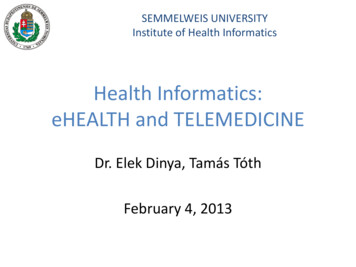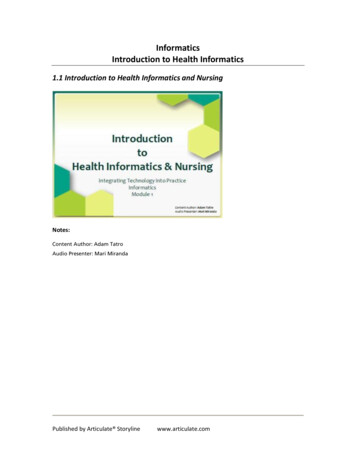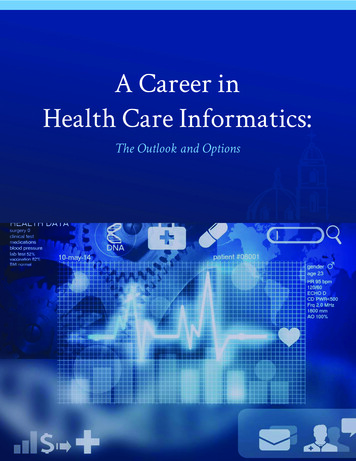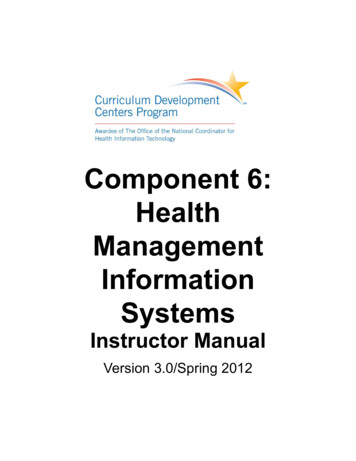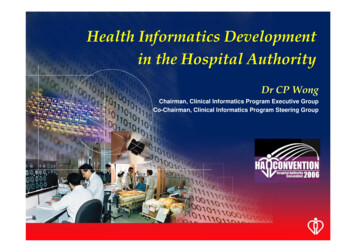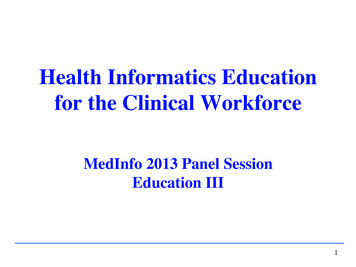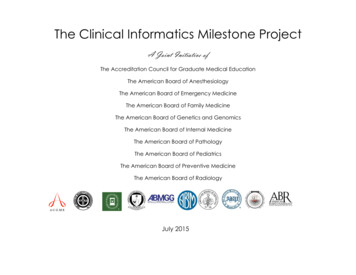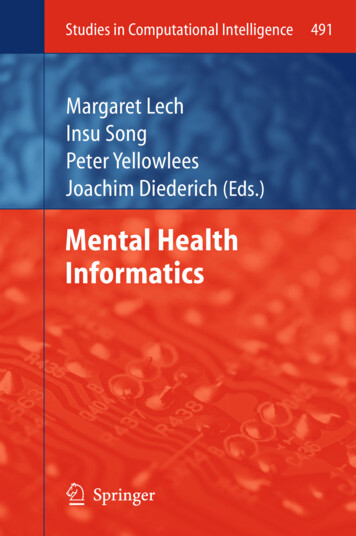
Transcription
Studies in Computational IntelligenceMargaret LechInsu SongPeter YellowleesJoachim Diederich (Eds.)Mental HealthInformatics13491
Studies in Computational IntelligenceVolume 491Series EditorJanusz Kacprzyk, Polish Academy of Sciences, Warsaw, Polande-mail: kacprzyk@ibspan.waw.plFor further volumes:http://www.springer.com/series/7092
About this SeriesThe series ‘‘Studies in Computational Intelligence’’ (SCI) publishes new developments and advances in the various areas of computational intelligence—quicklyand with a high quality. The intent is to cover the theory, applications, and designmethods of computational intelligence, as embedded in the fields of engineering,computer science, physics and life sciences, as well as the methodologies behindthem. The series contains monographs, lecture notes and edited volumes incomputational intelligence spanning the areas of neural networks, connectionistsystems, genetic algorithms, evolutionary computation, artificial intelligence,cellular automata, self-organizing systems, soft computing, fuzzy systems, andhybrid intelligent systems. Of particular value to both the contributors and thereadership are the short publication timeframe and the world-wide distribution,which enable both wide and rapid dissemination of research output.
Margaret Lech Insu SongPeter Yellowlees Joachim Diederich EditorsMental Health Informatics123
EditorsMargaret LechSchool of Electrical and ComputerEngineeringRMIT UniversityMelbourneAustraliaPeter YellowleesDepartment of Psychiatry and BehavioralSciencesUniversity of California, DavisSacramentoUSAInsu SongSchool of Business and ITJames Cook University AustraliaSingaporeJoachim DiederichPsychology Network Pty LtdBrisbaneAustraliaISSN 1860-949XISBN 978-3-642-38549-0DOI 10.1007/978-3-642-38550-6ISSN 1860-9503 (electronic)ISBN 978-3-642-38550-6 (eBook)Springer Heidelberg New York Dordrecht LondonLibrary of Congress Control Number: 2013951505 Springer-Verlag Berlin Heidelberg 2014This work is subject to copyright. All rights are reserved by the Publisher, whether the whole or part ofthe material is concerned, specifically the rights of translation, reprinting, reuse of illustrations,recitation, broadcasting, reproduction on microfilms or in any other physical way, and transmission orinformation storage and retrieval, electronic adaptation, computer software, or by similar or dissimilarmethodology now known or hereafter developed. Exempted from this legal reservation are briefexcerpts in connection with reviews or scholarly analysis or material supplied specifically for thepurpose of being entered and executed on a computer system, for exclusive use by the purchaser of thework. Duplication of this publication or parts thereof is permitted only under the provisions ofthe Copyright Law of the Publisher’s location, in its current version, and permission for use mustalways be obtained from Springer. Permissions for use may be obtained through RightsLink at theCopyright Clearance Center. Violations are liable to prosecution under the respective Copyright Law.The use of general descriptive names, registered names, trademarks, service marks, etc. in thispublication does not imply, even in the absence of a specific statement, that such names are exemptfrom the relevant protective laws and regulations and therefore free for general use.While the advice and information in this book are believed to be true and accurate at the date ofpublication, neither the authors nor the editors nor the publisher can accept any legal responsibility forany errors or omissions that may be made. The publisher makes no warranty, express or implied, withrespect to the material contained herein.Printed on acid-free paperSpringer is part of Springer Science Business Media (www.springer.com)
PrefaceOver the last years, the practice of delivering mental health services has changeddramatically. Information on mental health problems is widely available online andindexed for search, mobile devices are being used in large numbers worldwide, theconsumers of health services self-organise by use of social networks, medical andpsychological assessment is being automated step-by-step and consultation isincreasingly conducted via the Internet. Given the prevalence of mental healthdisorders and the burden on economies worldwide, mental health informaticsshould be a dedicated branch of Information and Communication Technology(ICT) or applied computer science.This book introduces a number of approaches that have the potential to transform the daily practice of psychiatrists and psychologists. This includes theasynchronous communication between mental health care providers and clients aswell as the automation of assessment and therapy. Fully automated versions ofcognitive behaviour therapy are currently available over the Internet and are beingused by millions of users worldwide. While the origins of psychometric testing goback to the nineteenth century and the methodology of psychological measurementis highly developed, the Internet revolution has advanced the science of psychological assessment not significantly beyond paper and pencil tests. A significantnumber of psychological tests are based on self-report or the observation of parentsand relatives as well as clinicians. While paper and pencil have been replaced byinput devices and tests are scored automatically, the very nature of psychologicaland cognitive testing has not changed significantly.This book offers a glimpse at the radical transformations that are awaiting thefield of psychological assessment. Even in developing countries, many individualsuse mobile phones (most people still have one mobile phone only, some haveseveral devices for professional and private purposes). Mobile phones record andtransmit speech, text and movement data. They store and communicate personalinformation, including search data, shopping behaviour and items identifyingcultural, social and other beliefs. Mobile devices are essential for social networking—the organisation of social tribes—and, consequently, the participation ofv
viPrefaceindividuals in physical or online groups. For the first time in history, the behaviourof hundreds of millions of individuals is being recorded, stored and analysed. Forthe first time ever, objective data about the behaviour of a significant portion of theworldwide population is available.Most psychologists and psychiatrists would agree that these data are valuablefor assessment purposes. Clearly, however, there are significant ethical and privacyconcerns that must be addressed while methods for the computational assessmentand treatment of mental health problems are being developed. Nevertheless, theinformation on movement and communication patterns, constantly recorded bymobile phones, has significant value beyond that of the traditional psychometrictesting techniques. As in other areas of information technology, these data (withpermission of the participants) can be used for the benefits of individuals and theirfamilies (i.e., assessment and treatment) and for a multitude of purposes in supportof the health and personal interests of consumers.Speech and language are particularly interesting from the viewpoint of psychological assessment. For instance, depression may change the characteristics ofvoice in individuals and these changes can be detected by a special form of speechanalysis. Some psychological problems result in changes in the use of language,such as the use of certain words and the avoidance of others, the inappropriateintroduction of new words to a language and a reduction of the overall vocabulary(e.g., schizophrenia). Computational screening methods that utilise speech andlanguage can detect subtle changes and alert clinicians as well as individuals andcaregivers.The importance of speech and language is further emphasised by the redefinition of some mental health categories that is currently underway. This preface iswritten a few weeks before the introduction of DSM-5, the fifth edition of theAmerican Psychiatric Association’s (APA) Diagnostic and Statistical Manual ofMental Disorders (DSM). It is currently assumed that Aspergers will not be part ofthis edition, which will be published in May 2013. DSM-5 will introduce a newcategory, Social Communication Disorder (SCD), which is a language disorderand as such different from Autism Spectrum Disorder (ASD) as defined in DSM-5.While the exact criteria for SCD are still unavailable at this point in time, it isassumed that this disorder will focus on a ‘‘qualitative impairment in socialinteraction’’. This moves the pragmatic aspect of language—the use in socialinteractions—to centre stage. Hence, the analysis of social interactions by computational methods will be essential for research on SCD and the development ofpsychological tests.As stated above, there is an abundance of data that can be used for theassessment and treatment of mental health problems. The use of these data,however, poses ethical problems that will occupy concerned individuals, governments and the wider public for a long time. Assuming that these ethicalproblems can be solved, it should be possible in principle to diagnose and treat
Prefaceviimental health disorders completely online (naturally, this excludes the use ofmedication). The long-term objective of this line of research is the assessment andtreatment of individuals with mental health disorders within a virtual environment.Brisbane, March 2013Joachim Diederich
Contents1Mental Health Informatics: Current Approaches. . . . . . . . . . . . .Joachim Diederich and Insu Song2The Rise of Person-Centered Healthcare and the Influenceof Health Informatics and Social Network Applicationson Mental Health Care . . . . . . . . . . . . . . . . . . . . . . . . . . . . . . . .Michelle Burke Parish and Peter Yellowlees345117The Changing Doctor-Patient Relationship:A Move to Anytime, Anywhere . . . . . . . . . . . . . . . . . . . . . . . . . .Najia Nafiz and Peter Yellowlees41Novel Approaches to Clinical Care in Mental Health:From Asynchronous Telepsychiatry to Virtual Reality . . . . . . . . .Abdullah Maghazil and Peter Yellowlees57Speech Analysis for Mental Health Assessment UsingSupport Vector Machines . . . . . . . . . . . . . . . . . . . . . . . . . . . . . .Insu Song and Joachim Diederich796Social Networks and Automated Mental Health Screening . . . . . .Insu Song and John Vong7Generating Explanations from Support Vector Machinesfor Psychological Classifications . . . . . . . . . . . . . . . . . . . . . . . . .Insu Song and Joachim Diederich125An Alternative Method of Analysis in the Absenceof Control Group . . . . . . . . . . . . . . . . . . . . . . . . . . . . . . . . . . . .Felin, Joachim Diederich and Insu Song1518107ix
x9ContentsStress and Emotion Recognition Using AcousticSpeech Analysis . . . . . . . . . . . . . . . . . . . . . . . . . . . . . . . . . . . . .Margaret Lech and Ling He10 Detection and Prediction of Clinical Depression. . . . . . . . . . . . . .Margaret Lech, Lu-Shih Low and Kuan Ee Ooi11 Automated Method for Diagnosing Speech and LanguageDysfunction in Schizophrenia . . . . . . . . . . . . . . . . . . . . . . . . . . .Anne Debra Tilaka, Joachim Diederich, Insu Songand Ai Ni Teoh12 Suicide Risk Analysis . . . . . . . . . . . . . . . . . . . . . . . . . . . . . . . . .Carol Choo, Joachim Diederich, Insu Song and Roger Ho13 Using Diagnostic Information to Develop a MachineLearning Application for the Effective Screeningof Autism Spectrum Disorders . . . . . . . . . . . . . . . . . . . . . . . . . .Tze Jui Goh, Joachim Diederich, Insu Song and Min Sung163185201217229Conclusions. . . . . . . . . . . . . . . . . . . . . . . . . . . . . . . . . . . . . . . . . . . .247Index . . . . . . . . . . . . . . . . . . . . . . . . . . . . . . . . . . . . . . . . . . . . . . . .249
Chapter 1Mental Health Informatics: CurrentApproachesJoachim Diederich and Insu Song1.1 IntroductionAccording to an AHRQ report [60], mental health disorder is one of the five mostcostly medical conditions in the U.S., with expenditures almost doubling from 1996to 2006. The number of people with mental health disorders to a similar degree.This has led to mental illness becoming one of most societies’ largest public healthburdens. The major challenges in mental health care can be grouped as follows: (1)availability of health care for remote and underserved population; and (2) makinghealth care more cost-effective and adequate. Developed mental health informaticstechnologies include traditional information management systems, such as electronic repository of patient information, electronic clinical summaries, and patients’care plans. These technologies have become critical as network of varying organizations (day hospitals, mental health centres, and small residential units) areinvolved in the management of mental health patients including chronically disabled patients [30]. One of the main challenges for mental health informationmanagement systems is the secure transfer of patient information.Most notable support in the advancement of mental health informatics has comefrom the Internet, in particular Web 2.0. The massive production of social mediaenabled by Web 2.0 drives a wealth of clinical knowledge, thereby providing anefficient platform for patients to support each other. According to a 2008 survey,most Americans (up to 80 %) rely on the Internet to find health information inorder to make their health care decisions [22]. This trend rivalled physicians as ofJ. Diederich (&)School of Information Technology and Electrical Engineering, The Universityof Queensland, Brisbane Q4072, Australiae-mail: j.diederich@uq.edu.auI. SongSchool of Business and IT, James Cook University Australia, SingaporeCampus 574421, Singaporee-mail: insu.song@jcu.edu.auM. Lech et al. (eds.), Mental Health Informatics,Studies in Computational Intelligence 491, DOI: 10.1007/978-3-642-38550-6 1, Springer-Verlag Berlin Heidelberg 20141
2J. Diederich and I. Song2008 [56]. An increasing number of patients (and families of patients) are alsorelying on the Internet for emotional support and to find clinical knowledge forself-care.Slow but steady progress has been made on automated/assisted assessmenttechnologies of mental health ranging from image based automated assessment ofstress and anxiety [13], acoustic speech analysis of depressed patients [40, 44], andtext analysis for the assessment of autism [59]. We do not expect to see fullyautomated mental health assessment and treatment systems in the near future, butmany clinical trials indicate their potential to be integrated into relatively wellestablished telepsychiatry (e.g., [68]).Except for health social networks (e.g., Health 2.0), which are mainly driven bycommunities, more extensive and structured clinical trials for quantitative analysisare required to bring about wider acceptance, as most studies still report anecdotalqualitative analysis [68] or studies based on small numbers of subjects.In this paper, we review current approaches to mental health informaticsfocusing on automated assessment methods, as we believe this is the currentbottleneck for providing more objective and efficient mental health care.1.2 Telemental HealthTelemedicine is the use of communication technologies, such as telephone, videoconferencing, or the Internet, to provide and support health care to remote regions.Telemedicine was initially developed to provide health care to rural and underservedpopulations [4], but distance is no longer the major factor that defines the term. Infact, its applications have been extended to all types of health care including psychiatry consultations in inner cities [34, 35, 68]. While the greatest benefits comefrom its use in rural and underserved populations, as it makes otherwise unavailablehealth care available to many patients, its driving force is now more on makinghealth care more cost-effective, affordable, accessible, efficient, and convenient forboth health care providers and consumers. For instance, Harrison et al. [33] evaluated teleconferences between doctors for improving communication between primary and secondary health care, [68] reported case studies of telepsychiatry viavideoconferencing and their potential to improve patient care and satisfaction, andreduce emergency department overcrowding. Frantzidis et al. [28] developed aremote monitoring system for the elderly and chronically ill. Tang et al. [63] used amultimedia system to improve medication adherence in elderly care. The growingnumber of aged population indicates that this form of telemedicine will become animportant research area for many developed countries.Almost all technologies we review here could be used in conjunction with telemental health technology. For instance, it will be possible to use automated speechanalysis methods (e.g., [24, 40, 59, 65]) while the patients are being interviewed bypsychiatrists to provide objective analysis of speech and language disorder or tomonitor improvements in mental health conditions.
1 Mental Health Informatics: Current Approaches3Much needed research is now being devoted to the development of moresophisticated tele-mental health technologies that integrate various technologies.This chapter reviews some of these technologies, with the aid of quantitativeevaluation, rather than anecdotal qualitative evaluations [68]. Chapters 2, 3, and 4of this book examine the use of modern communication technologies for telemental health and contemporary issues in mental health, such as how technology ischanging the way health care services are delivered and how the relationshipbetween patients and health care providers is changing.1.3 Automated Assessment SystemsMany mental health assessment methods are time consuming and highly subjective. To improve efficiency as well as to provide more objective assessments,various automated mental health assessment methods have been developed. Themethods can be broadly classified based on what type of data are collected andanalyzed.1.3.1 Image and Behaviour AnalysisCowie et al. [13] reviewed the use of image analysis techniques in detectingemotional cues from facial expressions (still face images) and gestures (movements of facial features). According to [13], two emotion detection paradigms areone detecting (seven) archetypal expressions and another one detecting nonarchetypal expressions (e.g., modulated, falsified, or mixed expressions). Themajority of existing literature and available data clearly focus on the method ofdetecting archetypal expressions (e.g., [48, 51, 67]). Much work needs to be doneon the detection of richer nonarchetypal emotional expressions and gestures. Theseapproaches now focus on the detection of action units (AU) defined by Ekmanet al. [21]. For instance, Valstar and Pantic [66] used a facial point detector basedon Gabor-feature-based boosted classifiers, achieving AU recognition rate of95.3 %. On the application of facial expression detection method on the diagnosisof mental health problems, Stone and Wei [61] used a facial expression detector tomeasure cognitive load, which is conventionally assessed using EEG or EMGmeasurements. However, there is little research on the use of facial emotionaldetection methods for clinical diagnosis of mental health problems. This may bedue to the fact that image processing techniques are more difficult than othertechniques, such as sound processing, and large variations on emotional expressions make it difficult to develop reliable measurements that are correlated withunderlying psychological problems.Instead of relying on face detection methods, Nambu et al. [45] developed asimple image processing technique for monitoring behaviours and diagnosing poor
4J. Diederich and I. Songhealth in the elderly. The researchers developed an automatic diagnosis systemthat can assess physical conditions as well as mental conditions from behaviours ofelderly watching TV. They used only the recordings of the start time of watchingTV obtained from a running monitor of the television. Initially, they tried to utilizevarious other sensors, such as a running monitor of electric appliances or doorswitches, but found the resulting data to be difficult to objectively analyze them, astheir data appear to be not correlated to each other. The start times of watching TVare recorded by dividing each day into 15 min intervals. An interval is given acertain value, say 1, when an elderly participant starts the TV in the interval andanother value, say 0, otherwise. This way, a 30 9 96 pixel image could be constructed for visualizing behaviours of elderly watching TV. Their hypothesis wasthat the subjects watched the television at roughly fixed times if they were healthy.To measure productiveness of their TV watching behaviour, the researchersmeasured non-randomness of the patterns on the visualized behaviour using themaximum entropy method (MEM). The image compression rate was measured asan indication of the health condition. The lower compression rate (larger size ofcompressed image) was used as an indication of unhealthy condition.1.3.2 BiosignalsBiosignals, such as skin conductance, EEG, EMG, and EGA measurements, havebeen used to monitor various physiological and psychological conditions. Sincethe introduction of affective computing [53], applications of bio-signals haveattracted a lot of research interest, but mainly on detection of emotion for theirapplication to human computer interactions. However, there are a few studies thattried to combine HCI and biosignals in medical applications (e.g., [5, 39, 41]).Here we review some examples.Tarvainen et al. [64] used derived features from galvanic skin responses (GSR)to detect emotional responses to external stimulus (surprising sounds). GSRresponses are produced by changes in the electrical properties of the skin inresponse to sweat gland functions responding to different kinds of stimuli. In asense, GSR are similar to skin conductance responses (SCR). Tarvainen et al. [64]derived the features using principal component analysis (PCA), and clusteringtechnique was applied to build a classifier that can distinguishing whether aresponse pattern belongs to a control or psychotic patient. Their method was testedusing measurements from 33 participants: 20 healthy controls and 13 psychoticpatients. It was observed that healthy controls showed clearer response patterns toexternal stimulus. The system achieved the overall correct ratings of 82 %. AsGSR measures are much easier to obtain than EEG signals, it has been used onwearable computers. For instance, Lisetti and Nasoz [39] used GSR in conjunctionwith heart rate and temperature monitors mounted on wearable computers tomonitor certain emotions (sadness, anger, fear, surprise, frustration, and amusement) noninvasively.
1 Mental Health Informatics: Current Approaches5Electrodermal activity (EDA) is another term for GSR. It also results fromsympathetic neuronal activity. Critchley [14] provides a detailed review of therelationship between the central nervous system, periperi, and EDA measures,indicating that a vast amount of information on mental and physiological conditions can be extracted from EDA measurements.Frantzidis et al. [28] developed a method of detecting early psychologicaldisorders by means of detecting frequent mood changes using EEG and EDAsignals. Their research was based on the assumption that affective states ofdepression, anxiety, and chronic anger negatively influence the human immunesystem [32]. This is a neurophysiology-oriented approach that monitors the subjects’ biosignals, providing a more objective mental health assessment. In theirapproach, EEG and EDA signals are recorded and features are computed. ERP,ERS, and ERD features are computed from EEG data, and SCR features arecomputed from EDA. Attribute selection is applied to EEG features using BestFirst search. The C4.5 data mining algorithm is applied to the selected EEGfeatures to generate valence discrimination function. The subjects’ gender and thevalence information extracted from the decision tree are then used to select one offour Mahalanobis distance functions (positive/negative pictures male, pos/negpictures female) for arousal discrimination. The Mahalanobis distance of thevector of selected features from the centre of the selected Mahalanobis distancefunctions are then used to estimate the arousal level. The result of the detection isone of four classes: LL (Lower valence-Low arousal), LH (Lower valence-Higharousal), HL (High valence-Low arousal), and HH (High valence-High arousal).Their average reported accuracy rate was 77.68 % for the discrimination of thefour emotional states, differing both in their arousal and valence dimension.1.3.3 Language Use in Patients with SchizophreniaSpeech and language disorders (SLD), such as incoherent discourse, occur invarious mental disorders, such as mania, depression, and schizophrenia [1, 19, 36].SLD is often termed thought disorder by schizophrenia researchers. Disorganizedspeech, such as incoherent discourse, has been considered one of the importantaspects in diagnosing schizophrenia [1]. Indeed, incoherent discourse is consideredan important symptom in diagnosing many psychiatric and neurological conditions[24]. DSM-IV [20] also uses disorganized speech as one of the diagnostic criteriafor schizophrenia. Therefore, various formal methods have been proposed in anattempt to characterize disordered discourse related to mental disorders. The followings are some of the well validated rating scales of thought disorder: theassessment of Thought, Language and Communication (TLC) [3], the ClinicalLanguage Disorders Rating Scale (CLANG) [9], the Communication DisturbancesIndex [17] and the Thought Disorder Index (TDI) [58].
6J. Diederich and I. SongSLDs occur in various mental disorders and provide critical information forassessing mental disorders. However, these formal methods are subjective, timeconsuming, and costly. Therefore, various automated SLD assessment methods fordiagnosing mental disorders have been developed. Examples include statisticalanalysis of letter and category fluency [8], Latent Semantic Analysis (LSA) basedspeech incoherence analysis [24, 25], Ex-Ray [16], and Discriminant-Words [59].SLD is also considered to be associated with cognitive impairments [15, 24]and as an early vulnerability indicator for schizophrenia [6, 42, 49, 52]. This isbecause schizophrenia is considered a neurodevelopmental disorder rather than aneurodegenerative disorder that occurs early in development, long before observable symptoms appear [18]. This suggests that deficits in brain function maypresent early in life [24]. This indicates that SLD analysis can provide earlydiagnosis of schizophrenia.We can broadly classify automated SDL analysis tools into three categories:1. Statistical analysis of letter and category fluency.2. Latent Semantic Analysis (LSA) Based Analysis of Speech Disorder.3. Machine Learning Approaches.Statistical analysis of letter and category fluency is an earlier approach thatmeasures word statistics of spoken or written content. LSA-based analysisapproaches go further into word-to-word, word-to-sentence, or sentence-to-sentence semantic relations. Machine learning approaches use derived features fromboth word statistics and semantic relations to build models of underlying mentalhealth conditions. Recent advances include generation of rules for explainingdiagnosis results in terms of the input features.1.3.3.1 Statistical Analysis of Letter and Category FluencyThe statistical analysis of letter and category fluency is one of the earliest SLDapproaches in diagnosing schizophrenic patients. It measures performance onverbal fluency and semantic fluency tasks. These are measured by counting thenumber of words generated to letter cues or category cues within a certain timeperiod [8]. Bokat and Goldberg [8] reported that patients with schizophrenia underperformed on both category and letter fluency tasks. In addition, they reportedthat schizophrenic patients demonstrated greater impairments on semantic fluencythan letter fluency. However, these approaches may provide very limited information on disordered discourse, as they rely mostly on linguistic features, such asvocabulary size of patients [24]. Some researchers (e.g., [24]) suggested thatcommunicative features, such as tangentiality (e.g., semantic similarity betweenquestions and answers), provide more relevant information as to the underlyingconditions [24].
1 Mental Health Informatics: Current Approaches71.3.3.2 Latent Semantic Analysis (LSA) Based Analysis of SpeechDisorderElvevag et al. [25] used Latent Semantic Analysis (LSA) [38] to measure coherence of speech, and reported its performance in discriminating speech generatedfrom schizophrenia patients and controls. They compared their research participants’ performance and correlation with a standard clinical measure of ThD (theScale for the Assessment of Thought, Language and Communication; and TLC[3]).The authors defined ‘‘coherence’’ of speech as the semantic similarity of wordsor sentences to words or sentences. The researchers measured discourse coherencein schizophrenics to assess abnormalities in the use of language to provideobjective and reliable assessment of coherence in discourses of schizophreniapatients. Their method could be able to discriminate schizophrenia patients withboth low and high ThD from controls. In particular, they showed that LSA couldbe used to identify which part of speech production is incoherent and estimate thelevels of incoherence.In their approach, four language tasks were designed: a word coherence test, averbal fluency test, a two-way dialog coherence test (between utterances), and asimilarity test between participants (
involved in the management of mental health patients including chronically dis-abled patients [30]. One of the main challenges for mental health information management systems is the secure transfer of patient information. Most notable support in the advancement of mental health informatics
